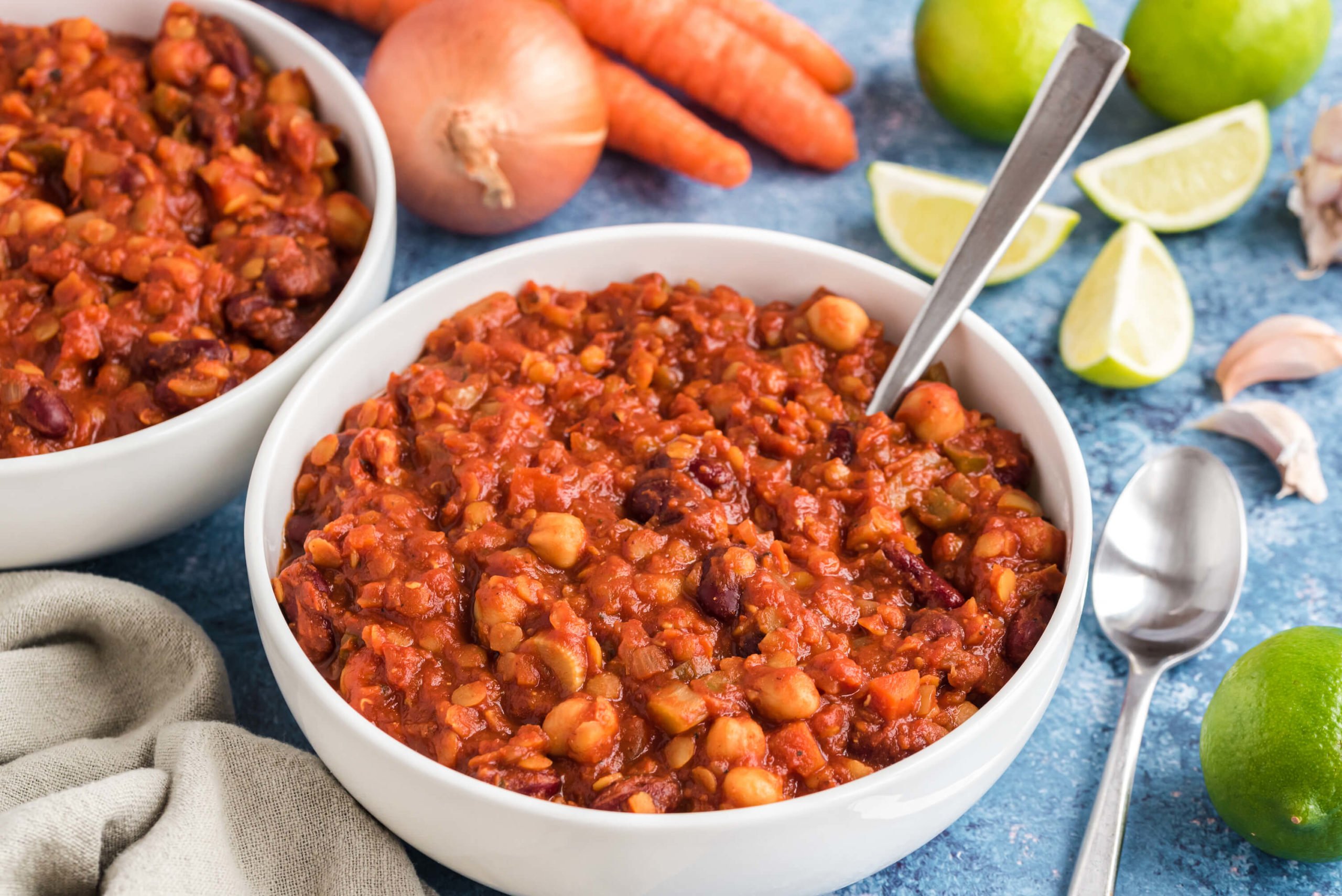Carroll Shelby was a man obsessed with speed. A celebrated race car driver and designer (portrayed by Matt Damon in the 2019 film Ford vs Ferrari), he competed in the grueling 12 Hours of Sebring race seven times, winning twice (as well as failing to finish five times, thanks to mechanical problems and, once, an illegal refueling pit stop). He designed the Shelly Cobra and the Ford Mustang, two of the most iconic cars of the 20th century. He was married seven times, including one marriage that lasted just a few weeks.
So, you might not think that this guy who lived his entire life in the fast lane would also be known for promoting one of the slowest foods on the planet: Texas-style chili. But as instigator of the first World Championship Chili Cookoff in Terlingua, Texas, in 1967 — and co-founder and CEO of the International Chili Society (ICS) three years later — Shelby started a movement that continues to this day. In 1991, a joint resolution of Congress named chili the official food of the United States. To this day, chefs compete in chili cookoffs, stewing their creations for hours until they achieve prize-winning flavors.
A Chili Obsession
From chili dogs to summer chili cookouts, the US is clearly still obsessed with chili. Texans claim it as their invention, despite the potentially inconvenient historical fact that chili con carne (chili with meat) probably originated in northern Mexico. Today, many regions have their own versions, and aficionados argue passionately about which ones are best and most authentic. According to the International Chili Society, cattle drivers in the Southwest likely created and popularized chili. And “chili queens” set up chili stands in Military Plaza in San Antonio, Texas during the 1880s.
The ICS speaks for meat-loving chili purists, insisting that authentic chili does not include “fillers” like beans or pasta, and consists entirely of ground meat (typically beef) flavored with chili pepper and other spices. Only in their “homestyle” category are such additions permitted (and, in the case of beans, required).
That’s a pity, because it’s additions like beans and veggies that not only contribute to a tastier and more interesting chili, but also turn it into a blazing health food. In this article, we’re going to explore how to make chili better by eliminating the meat. Not only will your recipes be healthier, they’ll be better for the planet as well.
And when you’re done reading, you’ll have five delicious veggie chili recipes to try!
Why Eat Chili?
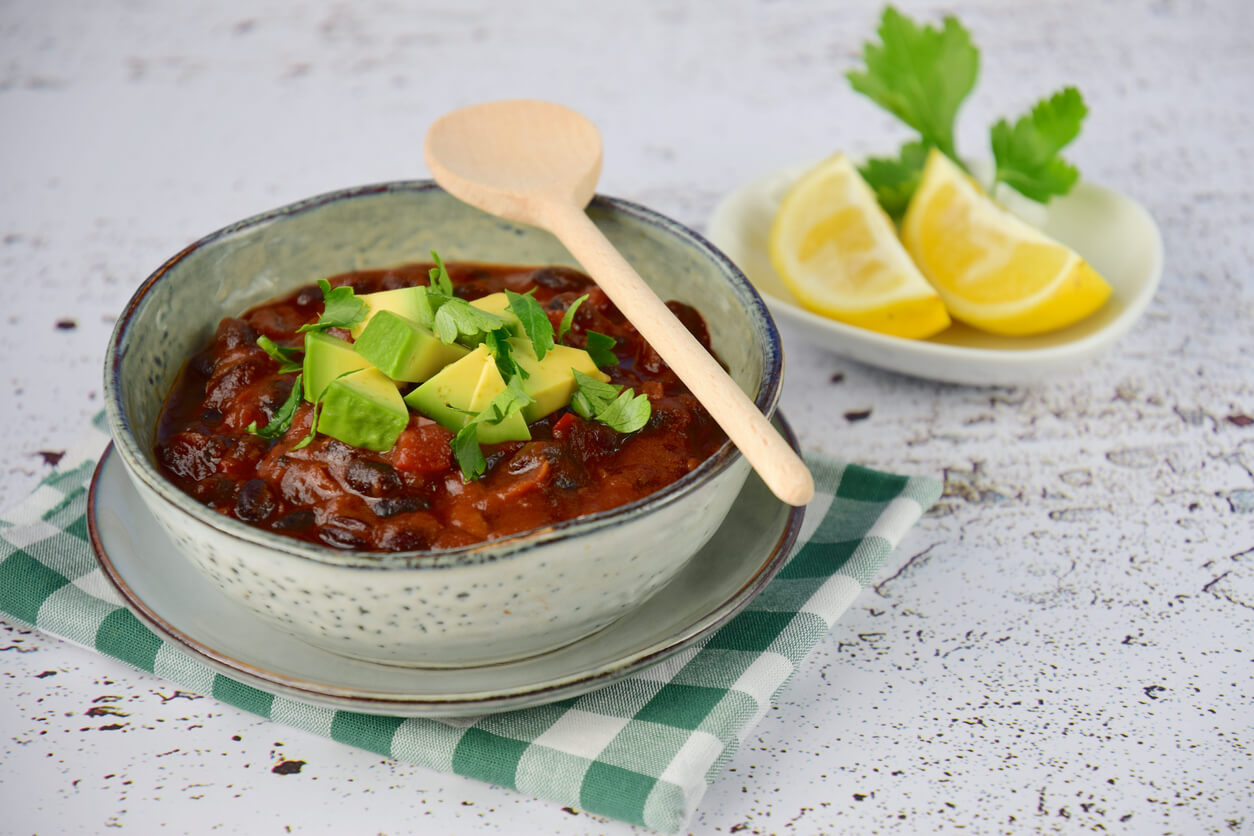
Chili is basically a red stew that traditionally contains meat (usually beef) along with spices, tomatoes, and sometimes beans and vegetables. But as we are learning, there are serious health and environmental problems with consuming beef. It’s associated with many cardiovascular and inflammatory diseases, and livestock are a primary contributor to environmental destruction and to climate change.
If you wanted to design an inefficient way to produce protein, you’d be hard-pressed to outdo cattle feedlots. They’re basically protein factories in reverse, turning vast quantities of soy, corn, and other feeds into relatively small outputs of meat. In fact, a 2016 Environmental Research Letter found that only 3% of the protein and calories that go into raising cattle make it onto consumers’ plates. The remaining 97% turns into hoof, hide, bone, manure, body heat, and the energy that the animals expend just by being alive.
A 2017 study found that if Americans traded their beef for beans, 42% of US cropland currently under cultivation for feed crops would be freed up for other uses, including growing crops directly for human consumption, rewilding, reforesting, and replanting of meadows and prairies.
Even if nothing about our energy infrastructure or transportation system changed — and even if people kept eating chicken and pork and eggs and cheese — swapping beans for beef could get us a major chunk of the way to meeting our greenhouse gas reduction targets.
Beans vs Beef
So you know where I’m going with this, right? I hereby proclaim the ICS restrictions on beans in all but “homestyle chili” null and void. In fact, maybe I’ll start the Benevolent Environmentally Awesome Network For Altering Recipes Transformatively (BEANFART) to promote swapping beans for beef in chili and other traditional meat dishes. (On second thought, unless I can do better on the acronym, maybe I shouldn’t.) But all humor aside, that small change can benefit your health, the animals, and the environment. Oh, and at one-fifth the cost (or less, depending on whether you used canned or dried beans), you can get a lot more bang for your buck as well.
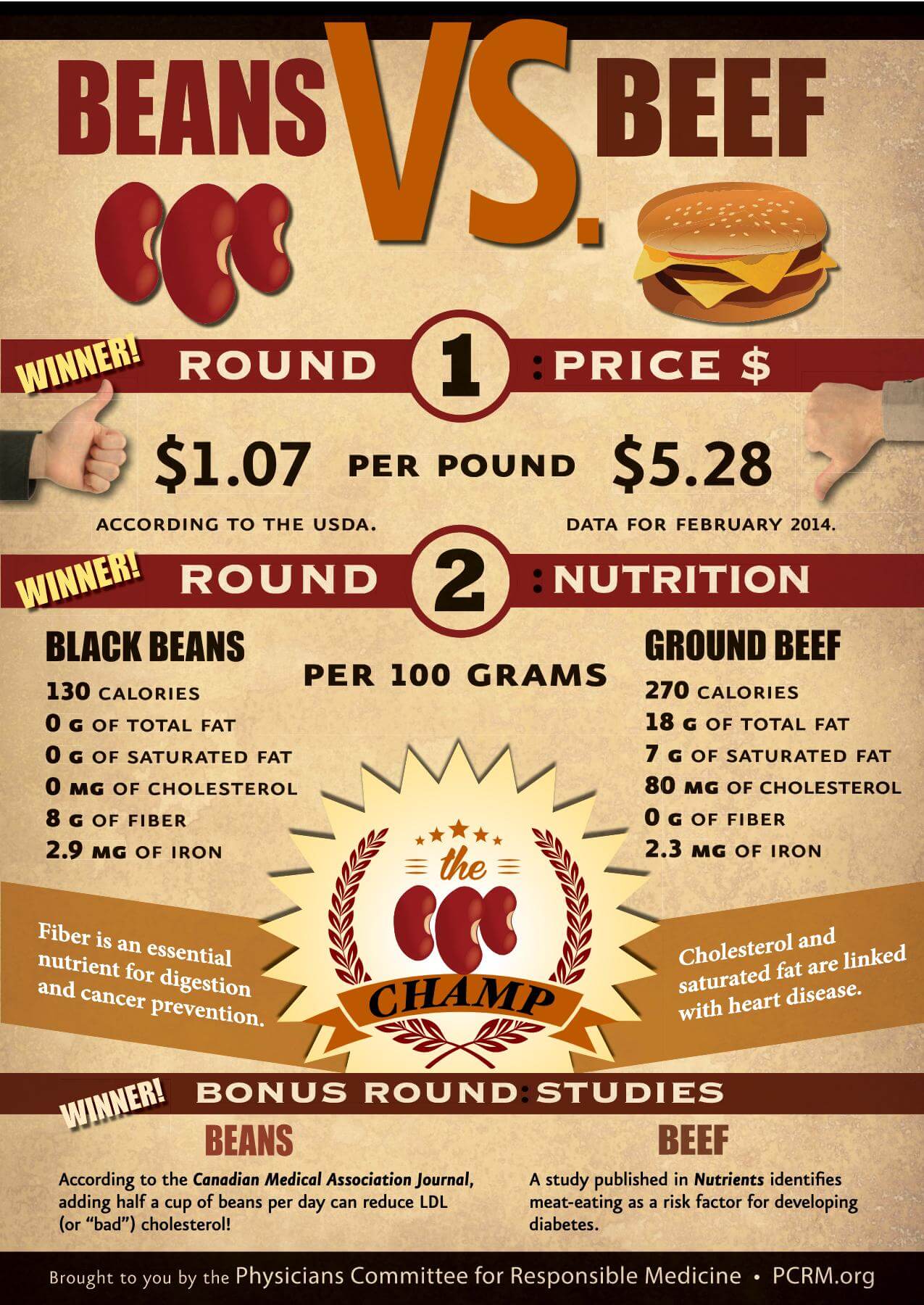
It’s not a big lift just to leave the meat out of a chili recipe that already contains beans. But if you’re hankering after that chewier eating experience, you can also replace ground meat with plant-based meat analogs, or whole plant foods that resemble the texture of meat.
Here are some examples (you can follow the links to our articles that explore each one in detail):
But Why Chili?

So, that’s why you might want to make plant-based chili instead of the con carne version. But why chili in the first place? What is it about that particular dish that makes it so awesome?
First, it’s easy to make. Sure, you might not win your local chili cookoff, but even the also-rans can taste pretty darn good! It’s a hard dish to ruin, as long as you cook it long enough and don’t let it burn. All you need is a stove, or even just a slow cooker or pressure cooker. The recipe instructions are generally some version of, “Throw all the ingredients into a pot and let them all simmer for a good, long time.”
Chili can also be very healthy. The plant-based version is typically centered around beans, which are one of the healthiest foods on the planet. In fact, the consumption of beans and other legumes is associated with a slimmer waistline and can help lower the risk of heart disease, diabetes, and some forms of cancer. Chili is also high in some health-promoting spices.
You can also get awfully creative with chilis, using different types and ratios of spices and other flavorings. Nathan Gramm won $2,500 in the 2021 ICS competition with his “Trailer Trash ‘Impossible’ Veggie Chili” that includes a cumin spice mix, dill pickle, pickled jalapeño peppers, and a combination of Impossible Burger and Impossible Sausage.
Chili is one of the world’s great leftover foods, too. You can batch cook it to use throughout the week, or freeze it for later consumption. You can serve it as a full meal, or as a side or ingredient in other dishes. And, chili is versatile. It tastes good hot or cold, so you can enjoy a warming bowl in winter, or try an unheated plate of extra-spicy to cool you down as the sweat evaporates off of your skin.
If you reheat chili (either on its own or with a starchy side like rice, pasta, or potatoes) after it cools, you’ll also reap the added health benefits of extra resistant starch.
Top Tips for Tasty and Healthy Vegetarian Chili
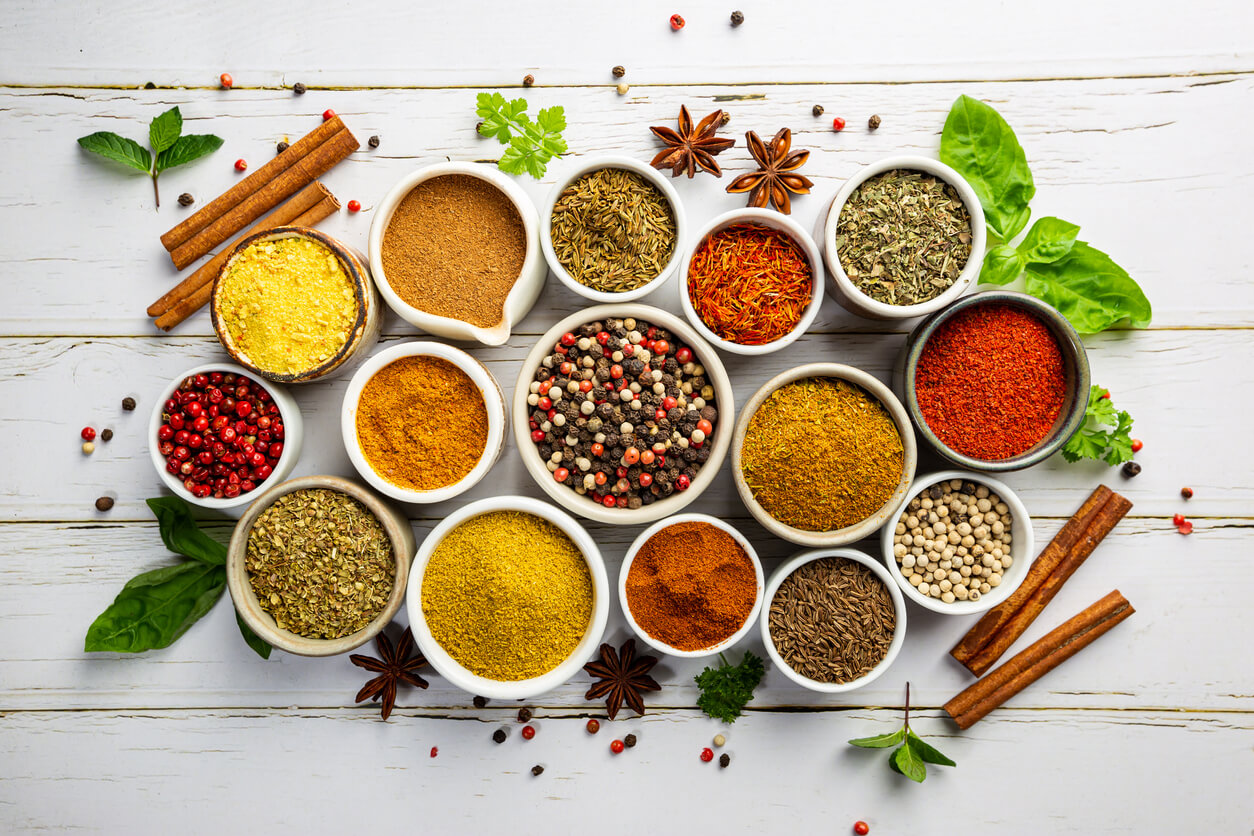
If Meghan Trainor is “All About That Bass,” then chili is all about those spices. You can mix and match, try new ones, and have an all-around creative time finding new and exciting flavor profiles. Common chili seasonings include some very healthy spices like chili pepper, black pepper, paprika, garlic, and onion (fresh, powdered, and granulated), as well as cumin.
Two flavorings that you may want to watch out for, though, are sugar and salt. Many chili recipes add sugar or other sweeteners to balance out the spiciness. Many of the ICS cookoff winners rely heavily on sugar to please the judges, but if you’re generally consuming a low-sugar diet, you can easily cut the amount of sweetener in mainstream chili recipes by half or more and still find them delicious.
In addition to the large quantities of salt that many recipes call for, canned beans themselves may be high in sodium. If you like, you can mitigate this by omitting extra salt, rinsing the canned beans, or cooking your own dried beans from scratch.
Speaking of beans, that’s another area for creative experimentation. There’s a long tradition of beans in chili, no matter what the ICS says. You can find 3-bean and 10-bean chilis, and you can combine beans of similar size in recipes so they all cook to the same level of doneness. Different varieties of beans can enhance the nutritional profile of chili, as they each contain different combinations and amounts of nutrients including protein and amino acids, fiber, vitamins, and minerals.
Veggie chilis with lots of different beans can also look beautiful, especially if you include colorful heirloom varieties like scarlet runner, cranberry, yellow eye, and black and white vaquero beans. Different beans will also contribute different textures and flavors to your chili, of course.
An Aside About Your Backside
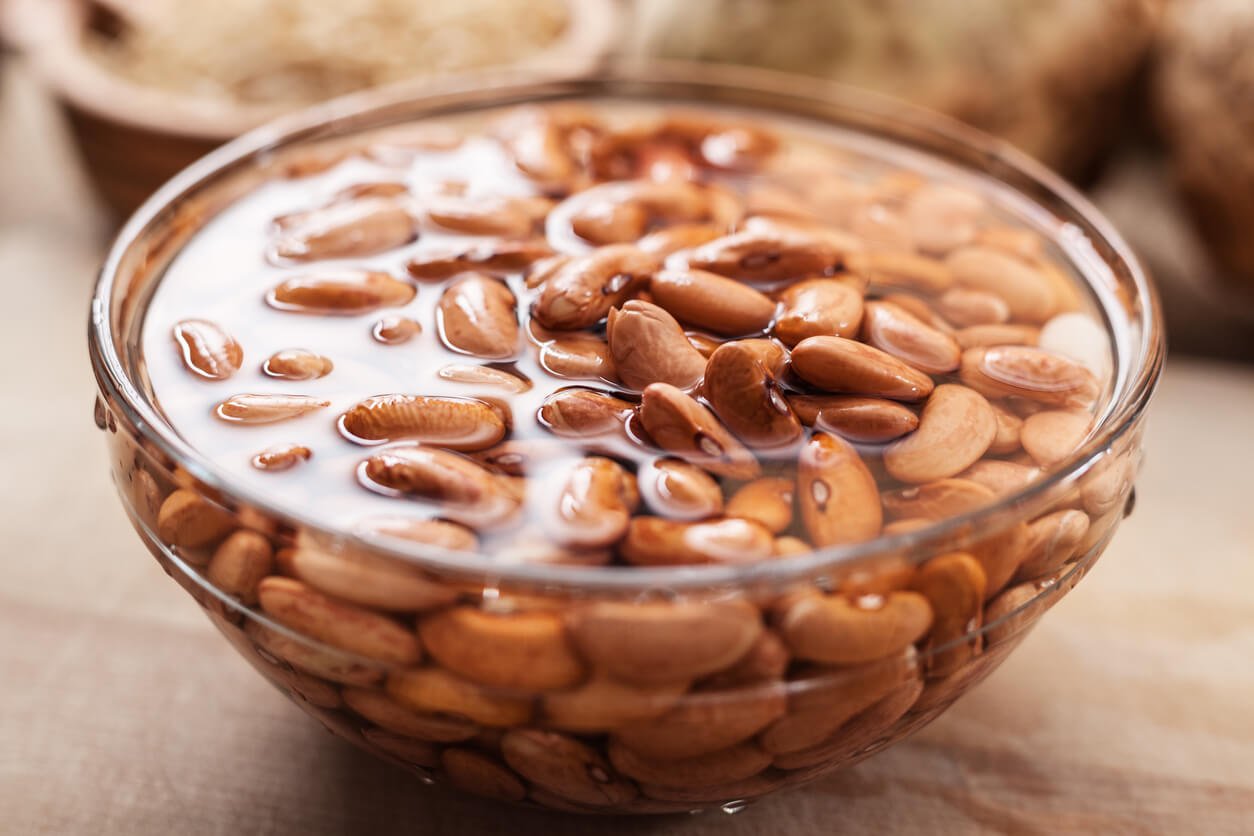
We can’t talk about beans and chili without talking about, well, that campfire scene in the 1974 Mel Brooks movie Blazing Saddles — in which, shall we say, these legumes earn their moniker as “the musical fruit.” Beans may cause gas and bloating in some people, especially those who aren’t used to eating them (or who aren’t used to getting much fiber in general).
The trick here is to buy clothespins for everyone’s noses (not actually recommended), or simply soak your beans for 24–48 hours before cooking them. Rinse them twice a day during this process to drain off the oligosaccharides (the medium-chain carbohydrates most responsible for turning our bottoms into wind instruments). If soaking doesn’t fully solve the problem, then you may want to ramp up to full servings of beans slowly. Add fewer beans to your chili, or else eat smaller portions as part of a larger meal that isn’t so bean-heavy.
Over time, your body may adjust to the abundance of fiber found in beans, and learn to digest them happily, quietly, and less pungently.
Sneak in Veggies

Healthy plant-based chilis, like many long-cooking stews, are an excellent way to sneak more vegetables into your diet (and that of family members who aren’t exactly on speaking terms with squash or leafy greens). You can add heft and flavor with root vegetables like sweet potatoes and carrots (both of which reduce the need for added sugar). Other great chili veggies include corn, mushrooms (which add that nice umami flavor and chewiness), and fresh bell or hot peppers.
Many recipes include tomatoes or tomato sauce, which provide a host of nutrients including lycopene (which is actually more bioavailable in cooked tomatoes).
You can also add fresh, raw toppings to your vegan chili to balance out the texture, flavor, and heat profile. That way, you get the best of both the raw and cooked worlds, since both are important for nutritional excellence and overall health. Some great raw complements to a steaming hot bowl include cubed fresh avocado, fresh herbs like parsley or cilantro, and diced fresh veggies like onions and jalapeño peppers (or even hotter ones, if you enjoy watching steam come out of your dinner companions’ ears).
To bring down the heat, on the other hand, you can add a dollop of a plant-based yogurt, sour cream, or cheese sauce.
What to Serve with Chili
Chili can certainly hold its own, anchoring a meal as a main dish, soup, or stew. If you want to organize your own plant-based chili cookoff, you might end up with a potluck featuring half a dozen different recipes!
Given how versatile chili is, there are also plenty of other ways to serve and eat it. These include:
- Over whole grains like rice, farro, quinoa, and so on
- As a topper for baked potatoes or sweet potatoes
- Over plant-based mac n’ cheese
- As a topper for carrot dogs
- In a breakfast hash with potatoes and tofu
- As a dip served with fresh-cut veggies
- Served cold over a taco-style salad
Plant-Based Chili Recipes
Feel all the warmth and comfort that veggie chili has to offer by choosing from the variety of recipes below. If tempeh is new to you, trying it (organic if you want to avoid GMOs) in our Champion Tempeh Chili is a great start. Swap out chicken for a fiber-rich, health-promoting, and planet-friendly option with Jackfruit Taco Chili. Support your immune system with hearty and flavorful Mushroom Chili. Smoky Bean Chili delivers a flavor bomb, plus lots of veggies and a variety of legumes. Finally, go wild — as well as tomato-free — with protein- and fiber-filled Slow Cooker White Bean and Millet Chili.
1. Champion Tempeh Chili
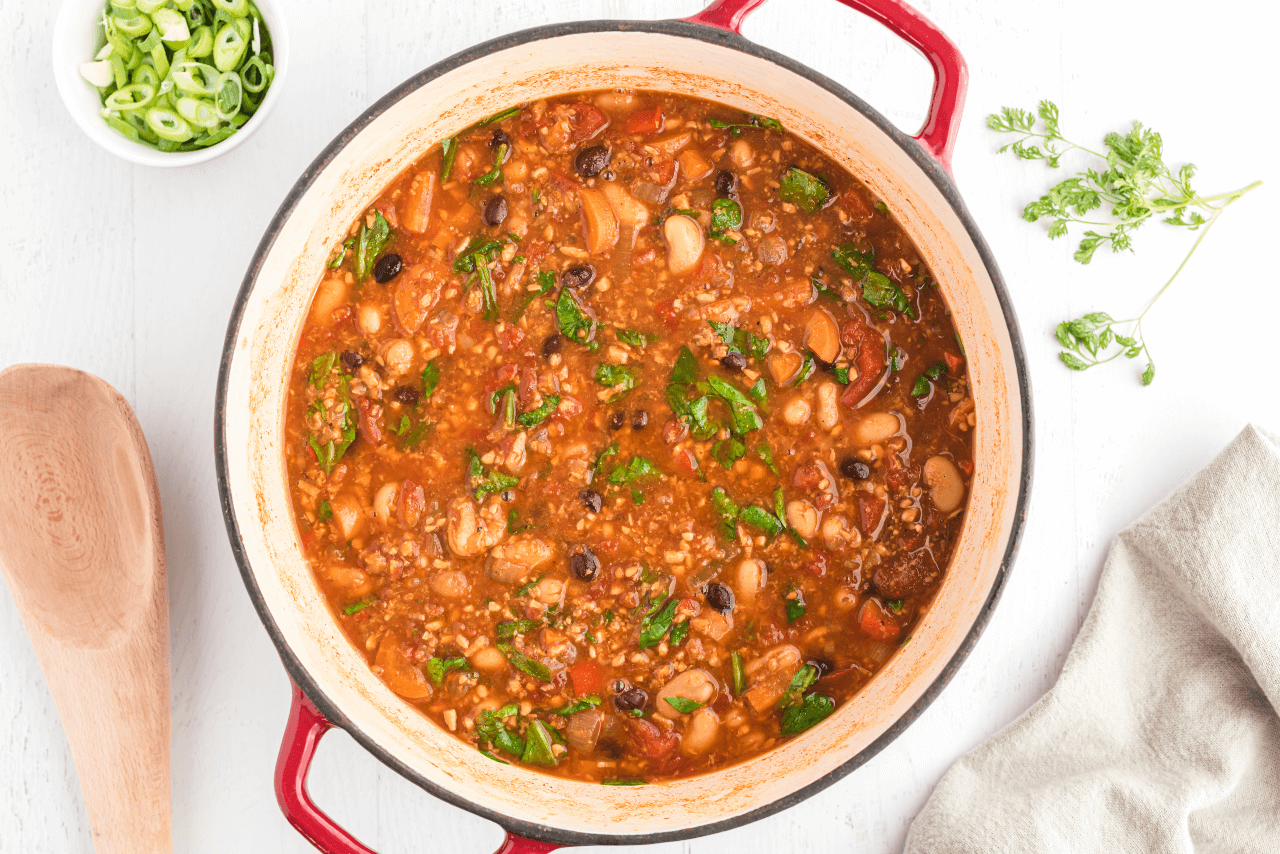
Love chili and want it to serve your health (and your family’s health)? We have you covered with this Champion Tempeh Chili. Tempeh and beans provide a meaty texture, while the spices and aromatics provide delectable flavors — and all of the ingredients provide a remarkable amount of nutritional value, too. This is a dish the entire family will love!
2. Jackfruit Taco Chili

Swap out chicken with jackfruit for a “pulled” meat type of chili that isn’t meat at all (and is better for you and the planet). When jackfruit is harvested early — before it has a chance to ripen and become soft and sweet — it has a neutral flavor and satisfyingly chewy texture, making it a perfect substitute for meat in a variety of dishes. Get ready to add this one to your plant-based recipe library, because it’s going to go over really well with the whole family. If it’s just for you, on the other hand, hooray for leftovers! It’s even better the next day.
3. Mushroom Chili
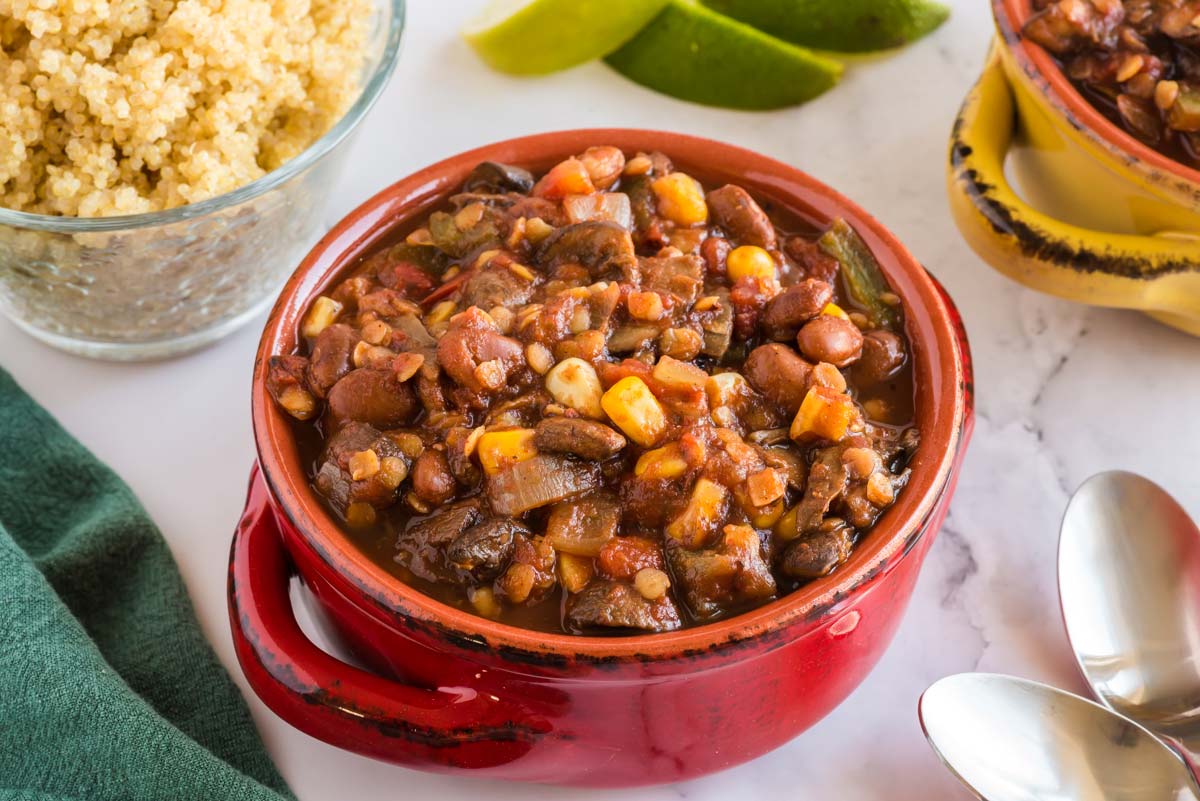
So hearty, so flavorful. This chili is a crowd pleaser! Don’t let the deceptively long list of ingredients deter you; it’s actually quite simple and very much worth the (little bit of) effort! Mushrooms have been shown to help fight heart disease, cancer, and inflammation, making this a delicious way to nurture your plant-based health.
4. Smoky Bean Chili

Fragrant and healing spices can help to diversify any dish because of the unique flavor that each individual spice imparts. Smoked paprika infuses a smoky (but not spicy) essence into this version of bean chili. In just one hearty serving, you’ll get a variety of vegetables: onions, green bell pepper, celery, and carrots — as well as a variety of legumes: kidney beans, chickpeas, and lentils. With that kind of variety, you might also call this the gut-loving chili!
5. White Bean and Millet Chili
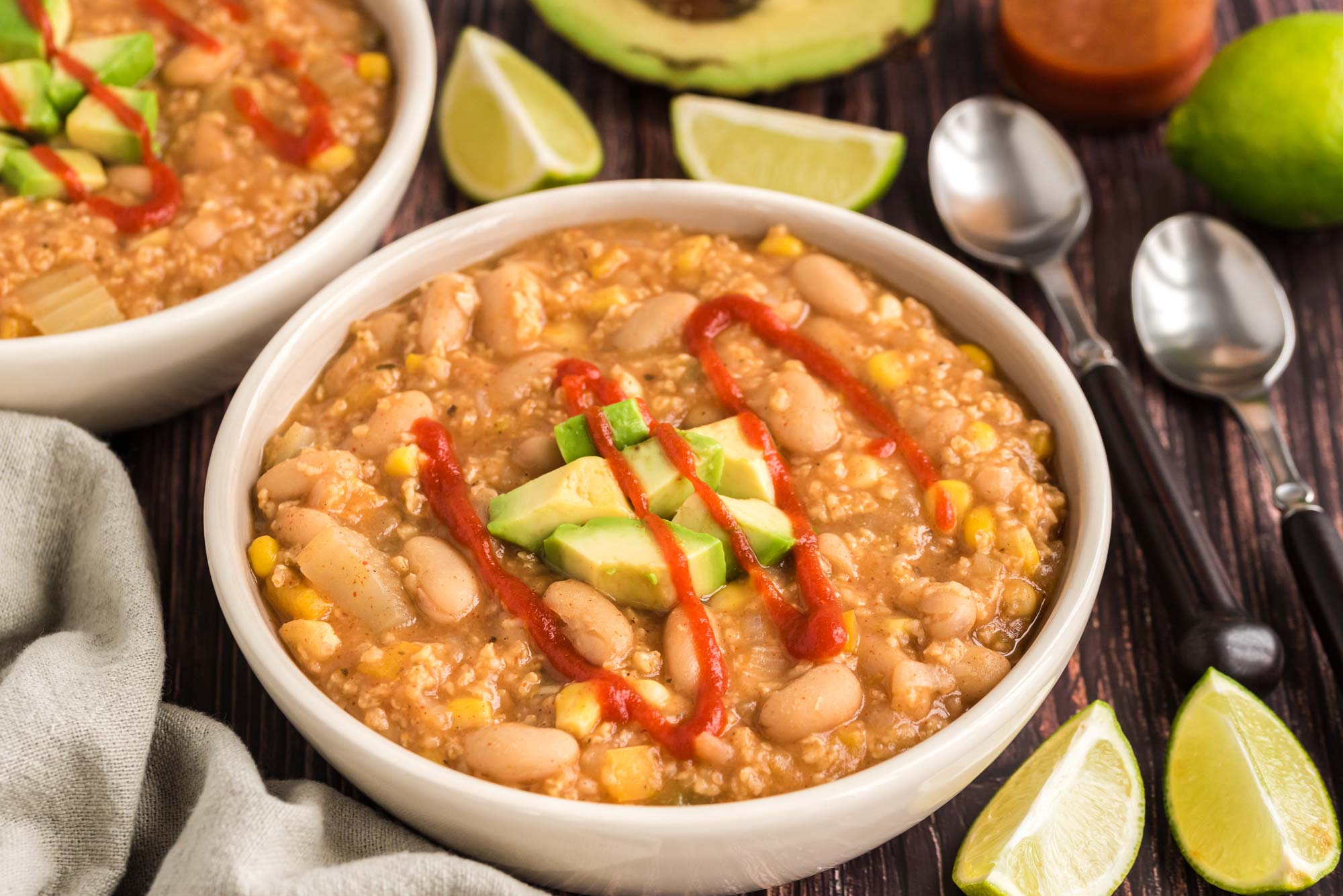
Slow Cooker White Bean and Millet Chili puts a new spin on traditional chili, with white beans, naturally gluten-free millet, and a decided lack of tomato base. The combination of beans and millet means more substance for the chili, and more plant-powered protein and fiber for you. This easy-to-prepare one-pot slow cooker meal is flavorful, satisfying, and comforting!
Conclusion
Chili is well-loved throughout the world, with a special affinity for the American Southwest. Although it often contains beef, you can create healthy chili without meat by swapping it with beans to benefit your health and the environment, and — with all due respect to the International Chili Society — for a better tasting dish!
Tell us in the comments:
-
What’s your favorite kind of chili? Have you ever made it plant-based?
-
How do you feel about spicy foods? Do you prefer mild, “hit me again, harder,” or something in between?
-
What beef alternatives are your favorites?
